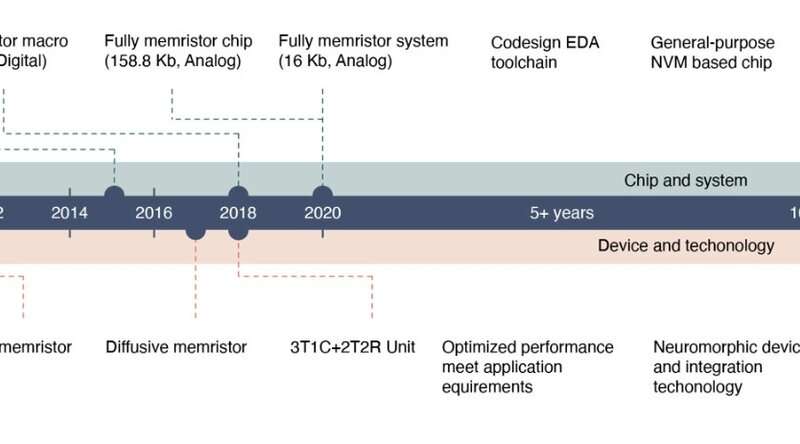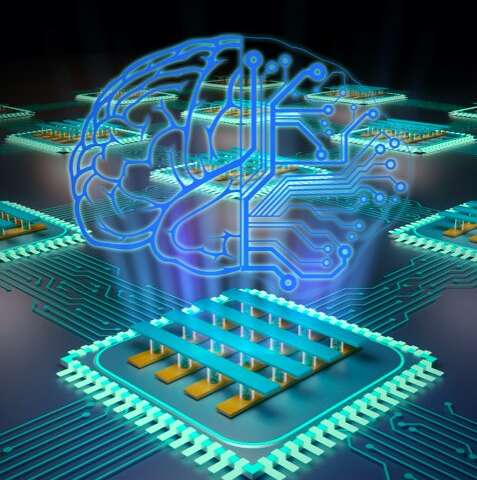CLOSE
About Elements
TANAKA is a leading company in the field of precious metals.
Advanced materials and solutions that support societal progress, the development stories behind them, the voices of engineers, and our management philosophy and vision—
Elements is an online media platform that shares insights that lead to a better society and a more prosperous future for the planet under the slogan “Mastering Precious Metals.”

Reviewing recent advancements in the development of neuro-inspired computing chips


The future roadmap of NVM based neuro-inspired computing chips. Credit: Zhang et al.
In recent years, many research teams worldwide have been developing computational techniques inspired by the human brain, such as deep learning algorithms. While some of these techniques are considered highly promising for a wide range of applications, conventional hardware does not always support their computational load and thus can limit their performance.
A possible solution for overcoming the limitations of existing hardware and ensuring that brain-inspired computational techniques achieve optimal results entails the creation of new electronic components that better reflect the structure of the human brain. A class of neuro-inspired computing chips is specifically designed for artificial intelligence (AI) applications that mimic the neural structures in the brain of humans and other animals.
Researchers at Tsinghua University in China have reviewed recent advancements in the design of neuro-inspired computing chips to gain insight on the progress made so far and identify challenges that still need to be overcome. Their review paper, published in Nature Electronics, also outlines a series of co-design principles that could inform the development of new neuro-inspired circuits, devices and algorithms.
“The idea for our paper came from our previous attempts at designing neuro-inspired computing chips,” Huaqiang Wu, one of the researchers who carried out the study, told TechXplore. “In our past studies, we found that it is difficult to optimize the performance of these chips on an individual level, such as the device or circuit level, and that such a chip needs to be optimized with co-design strategies that cover a broad range of elements, from devices to algorithms.”
In their new paper, Wu and his colleagues closely examine recent developments in the design of neuro-inspired computing chips and reflect on some of the lessons learned from their own efforts in the field. In addition, they outline a set of benchmarking metrics and co-design principles that could assist others who are trying to develop these chips.
“We hope that our work will help non-expert readers to find out more about neuro-inspired computing chips, while also promoting greater development in this field of research,” Wu said. “We mainly examined neuro-inspired computing chips in terms of their potential for supporting algorithms, spiking neural networks or artificial (deep) neural networks.”

An abstract representation of a neuro-inspired computing chip. Credit: Zhang et al.
Wu and his colleagues highlight four metrics that engineers could focus on when trying to evaluate the effectiveness of neuro-inspired computing chips: computing density, energy efficiency, computing accuracy and on-chip learning capability.
When reviewing past studies, the researchers observed that these metrics were the most crucial for the design and optimization of neuro-inspired computing chips, as they best represented the chips’ unique features and their possible advantages over traditional chips. For instance, computing density, a metric that reflects a chip’s area efficiency, ultimately allows engineers to determine how much information their chips can store at once and whether their memory is sufficient to run large-scale neural networks.
In addition to outlining important metrics for evaluating brain-inspired chips, Wu and his colleagues introduced a set of co-design principles that could serve as a reference for future research in the field. These principles are largely based on their past research findings and observations.
“We think that the co-design tool we proposed is the most important part of our study,” Wu said. “In the practical neuro-inspired computing chip design, without this co-design tool, it is hard to achieve a high-performance chip. For example, nonvolatile memory (NVM) devices, which could be used as synaptic memory, usually have intrinsic non-idealities and these non-idealities will drop the performance of chip. Reducing the non-idealities at the device level, however, requires lots of effort, and we cannot remove them entirely. Our co-design tool could thus help to optimize the performance of a chip not only at the device level but also at the circuit or system levels.”
Their review paper could ultimately serve as a general roadmap for engineers who are trying to develop brain-inspired chips. Meanwhile, Wu and his colleagues are planning to devise other guidelines that could speed up and facilitate research in the fields of artificial intelligence (AI) and neuro-inspired electronics.
“In our future research, we could divide designing neuro-inspired computing chips into two parts,” Wu said. “In the device fabrication and technology integration part, we will optimize the performance of devices, fabricate new neuro-inspired devices and explore three-dimensional neuro-inspired computing chips. In the chip and system part, on the other hand, we will develop a co-design tool and design a general-purpose neuro-inspired computing chip, especially the NVM based computing-in-memory chip.”
Explore further
Researchers discover unique material design for brain-like computations
More information: Wenqiang Zhang et al. Neuro-inspired computing chips, Nature Electronics (2020). DOI: 10.1038/s41928-020-0435-7
© 2020 Science X Network
Citation: Reviewing recent advancements in the development of neuro-inspired computing chips (2020, August 20) retrieved 20 August 2020 from https://techxplore.com/news/2020-08-advancements-neuro-inspired-chips.html
This document is subject to copyright. Apart from any fair dealing for the purpose of private study or research, no part may be reproduced without the written permission. The content is provided for information purposes only.
This article was from Tech Xplore and was legally licensed through the Industry Dive publisher network. Please direct all licensing questions to legal@industrydive.com.
![]()







